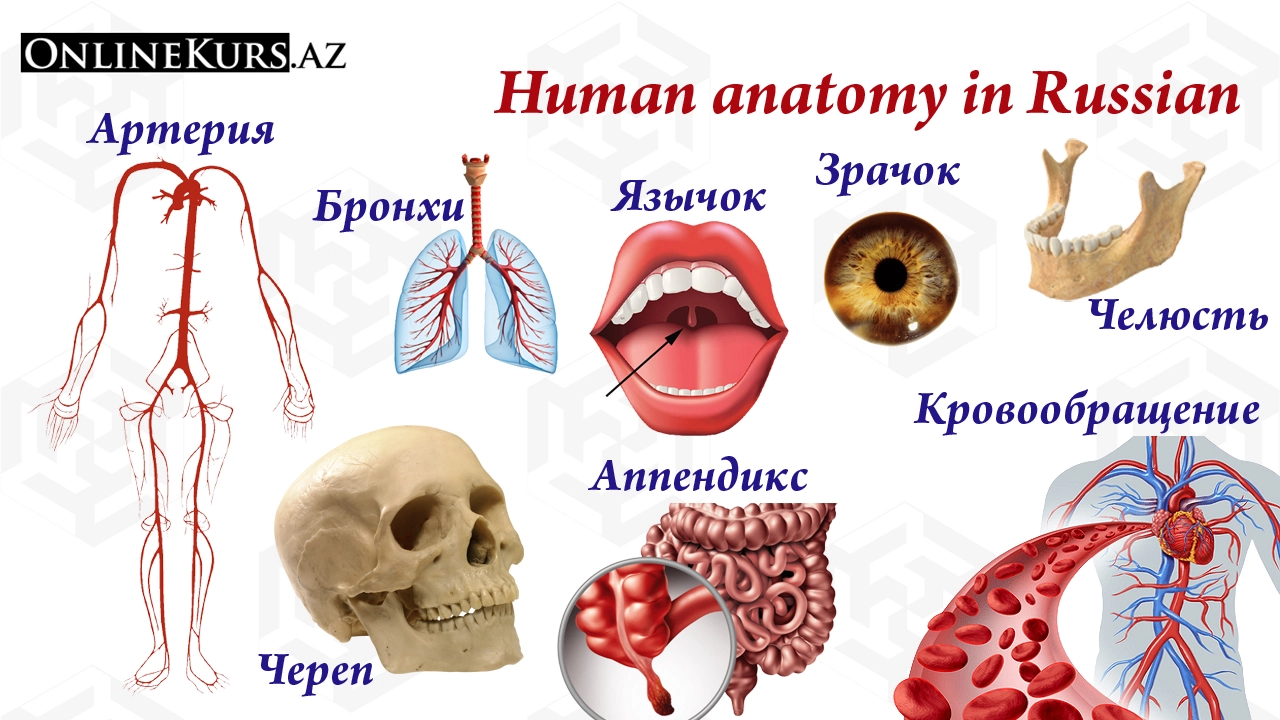Human anatomy in Russian
In this lesson we will learn new words on the topic: Russian words on anatomy.
Russian words related to anatomy
In this lesson we will continue the topic of anatomy in Russian. In the last lesson, we learned a few words about human anatomy in our lesson called Human Anatomy Part I. Anatomy is the study of the structures associated with the human body. The human body is often thought of as a complex machine. The machine must have all its parts to work, but in addition, each of these parts must work optimally. If a person's organs do not work properly, then that person has a disease. This is when you consults a doctor, and if you are in a Russian-speaking country or your doctor is Russian-speaking, then you should talk to him in Russian. So, learning Russian words on human anatomy can be useful for you.
So, if you are reading this article, then you want to learn words in Russian on anatomy in the easiest and fastest way. The good news - you're in right place! Perhaps you have already spent some time looking at various resources that teach Russian words on human anatomy, and you feel extremely tired of the multitude of choices. Indeed, the time and effort you waste to find the resources you will use to learn can be more stressful than learning!
First of all, with the words included in the dictionary of this lesson, you will learn not only words about human anatomy in Russian, but also words related to animal anatomy. So, almost everything about our internal anatomy applies to other mammals, and most of them generally belong to vertebrates.
So, let's learn words on human anatomy in Russian. Of course, in Russian we can discuss the structures of human anatomy at the subcellular level, for example, from the cell nucleus to the molecular level. However, it is very technical in nature, and the word is less interesting in terms of language, because most of the vocabulary is of Greek-Latin origin. Therefore, let's focus on the main organs in this lesson.

In most cases, the individual bones ("кости") in the skeleton ("скелет") are named after the parts of the body in which they are located, for example, the femur in Russian is called "бедренная кость" using the adjective form of the word thigh ("бедро"). However, some bones have their own special names. An example is the word rib ("ребро").
The human body is a real miracle. Children of any age are interested in discovering their bodies. The study of human anatomy in Russian begins with an introduction to body parts. But sometimes it is not interesting to study the organs only from the anatomical and physiological point of view. Children spend a lot of time in learning Russian language, and we decided to diversify the topic of Human Anatomy in Russian, which we learned in the Russian language course, based on additional materials from phraseology and ethnography.
People use idioms and proverbs in their speech because they make it easier to express their thoughts, feelings and experiences, and it is easier to communicate with others. The language, on the other hand, becomes brighter and more imaginative thanks to stable folk sayings. We hear them from childhood, read them in books, and learn to use them properly in our speech. Let's learn Russian proverbs on human anatomy.
Russian proverbs on human anatomy
"Кто родом кулак, тому не разогнуться в ладонь." - Anyone who comes from a fist cannot bend into a palm. (The meaning of this proverb can be understood on the basis of his reference to lineage and tribe.)
"Одна челка хорошо, а две лучше." - One fringe is good, but two are better.
"Череп пьет - черт крестится." - The skull drinks - the devil crosses himself.
Writing and pronunciation of words on Russian about human anatomy.
|
|
[ бр’ушн`ай’а п`оласт’ ] | Abdomen |
|
|
[ зрач’`ок ] | Pupil |
|
|
[ арт’`эр’ий’а ] | Artery |
|
|
[ краваабращ’`эн’ий’э ] | Blood circulation |
|
|
[ ч’`эр’ип ] | Skull |
|
|
[ бр`онха ] | Bronchus |
|
|
[ г`орла ] | Throat |
|
|
[ б’`уст ] | Bust |
|
|
[ икра н`ог’и ] | Calf |
|
|
[ пласкаст`оп’ий’э ] | Flat-foot |
|
|
[ ск`ула ] | Cheekbone |
|
|
[ ч’`эл’уст’ ] | Jaw |
|
|
[ падбар`одак ] | Chin |
|
|
[ тр`уп ] | Corpse |
|
|
[ й’амка на щ’ик’э ] | Dimple |
|
|
[ ч’`элка ] | Fringe |
|
|
[ д’исна ] | Gum |
|
|
[ р`од’инка ] | Mole |
|
|
[ п`упок ] | Navel |
|
|
[ лад`он’ ] | Palm |
|
|
[ сл’уна ] | Saliva |
|
|
[ ап`эн’д’икс ] | Appendix |
|
|
[ п`ол ] | Sex |
|
|
[ б’идр`о ] | Thigh |
|
|
[ й’изыч’`ок ] | Uvula |
|
|
[ пазван`ок ] | Vertebra |
|
|
[ сас`ок ] | Nipple |
|
|
[ кал’`энай’а ч’`ашыч’ка ] | Kneecap |
|
|
[ мар’щ’`ина ] | Wrinkle |
|
|
[ гал’инаст`оп ] | Ankle |
We believe that the education should be free and available to everybody. This is why some time ago, we made a decision to continue developing as a completely free network. But we need the support of our readers to continue creating new content, keep the development going and pay related expenses. If you like what we do and find it helpful, consider supporting us by making a donation to our accounts.